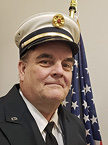Editor’s Opinion Ed Ballam
Because I am who I am, I listen to the fire radio almost nonstop. I don’t know how my wife deals with it, but she does, and I try to be respectful as to not interfere with quiet or TV time or sleeping, but it’s on almost all the rest of the time.

I like listening to what other area departments are doing. You never know what you’ll hear. For instance, the other day I listened to a medical call dispatched for difficulty breathing—arguably one of the most common calls in the EMS arena. No big deal. But, as the dispatcher relays more information, this call becomes more serious. The dispatcher says, 65-year-old female, difficulty breathing. Adds, has fallen down a steep embankment Whoa … that’s a different call now. Maybe it’s a technical rescue or, at the very least, a far more challenging patient extrication.
- Ed Ballam | Better to Be Seen Than Viewed
- Ed Ballam | Catch the Electric Wave
- Ed Ballam | Are You Ready?
- Ed Ballam | What’s New from the FDIC International 2022 Show Floor
- Ed Ballam | Remembering Who Pays the Bills
- Ed Ballam | A Breath of Fresh Air
- Ed Ballam | Managing Resources
- Ed Ballam | Resolve to Keep Learning
- Ed Ballam | Wake Up and Smell the Coffee
More information follows. She landed in a bees’ nest and has been stung multiple times. That’s an interesting development—firefighter safety is now more involved than previously. Patient says she can’t get out of the embankment and thinks she is having an allergic reaction. Now this is a very real emergency.
You can’t make this stuff up. Well, you can, but it usually comes from the mind of a very creative instructor making up a teaching scenario that challenges students. This one, however, was real life. Think about how that escalated in seconds from a routine call to a potentially life-threatening event. And, just to satisfy everyone’s curiosity, the patient was extricated from down over the embankment, she was evaluated, and the EMTs on the scene got an informed refusal of care, or sign off, and there was no transport provided. No further treatment was needed. The firefighters with the rescue equipment cleared the scene as did the ambulance—returned to quarters in service. Phew. Mission accomplished and everyone went home.
I was listening to another call recently. Midday call for a smoke investigation, possibly from the roof of a structure, possibly from an outside fire in back of it. One of those who-knows-until-you-get-there calls. Turns out, it’s a three-alarm structure fire on Main Street in an historic building next to an even more historic church. Again, that escalated quickly, from a smoke investigation to a conflagration that destroyed an 1874, three-story brick schoolhouse building, complete with steeple and bell. Multiple towns were summoned to the scene and firefighters spent more than eight hours just fighting the blaze and many more on a fire watch looking for rekindles. Oh, for those inquiring minds who want to know, the owner was using a heat gun to remove paint on the eaves of the structure, and it’s likely that’s what caused the blaze.
The situation blossomed quickly, from a spark in the eaves of the building, with a homeowner using an extinguisher, to a garden hose, to a full-blown third alarm assignment to put out the blaze. But, in the end, the fire was put out. Mission accomplished and everyone went home.
It being September again, I can’t help but think of the firefighters in New York. We made a promise to never forget their sacrifices. I wasn’t there to hear the radio transmission, but after-the-fact reports indicate that nobody thought it was initially a big deal—well, at least not on the scale to which it ended.
I am sure the initial response team was thinking a plane into the World Trade Center, not your normal call by any stretch but one that likely seemed a manageable job. Many thought it was a small plane, probably some exterior damage to the building, most likely a couple of dead pilots, but for New York city, absolutely manageable.
Then, there was the chilling reveal that it was a huge jet, full of passengers and fuel, into the upper floors of the city’s tallest building. Occupants trapped above. Hundreds dead on the involved floors, injured and dead below as burning fuel permeated the building. It was a genuine horror scene.
The second plane hits the second tower. The scene literally explodes into an exponentially bigger mass casualty event that is starting to take the responders’ lives. It was hell on earth.
Think about the next radio reports, the towers are known to be compromised, but the unthinkable happens and one collapses and then the next and the falling debris claims civilians, 343 Fire Department of New York firefighters, and created an indelible smudge on our nation’s history that will never be forgotten. We all known the stories of heroism and sacrifices. We must never forget them.
We must also never forget that even the most routine calls can quickly turn to (expletive deleted) quickly requiring our “A game” and challenge us in life-changing, unimaginable ways. We must always be ready for anything from difficulty breathing calls that turns to poop, smoke investigations that end up claiming historic structures, or plane crashes that change the course of world history.
We all have our jobs to do, and the missions will be accomplished, but not all of us get to go home. We must never forget that.

